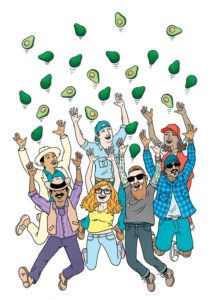 Under the volcanoes in Mexico’s Michoacán state, violent cartels are fighting to dominate a shadowy and lucrative market. One gang, called La Familia Michoacana, announced its presence about a decade ago by tossing five rivals’ heads onto a dance floor in the town of Uruapan. The Knights Templar muscled in next, spouting a chivalric code of honor as it taxed, extorted and kidnapped farmers and usurped their land. Mexican security forces and local landowners have tried to fight back, but warring cartels continue to splinter and proliferate. In March, an armed group known as Los Viagras — apparently named for the way their leader’s heavily moussed hair stands up — wreaked havoc by burning dozens of vehicles and effectively shutting down the state’s main highway. One conflagration took place not far from where an American businessman named Steve Barnard owns a packing plant in Uruapan. “It’s too dangerous to drive on the roads,” Barnard says. The farm owners “have to be very careful not to get kidnapped.”
Under the volcanoes in Mexico’s Michoacán state, violent cartels are fighting to dominate a shadowy and lucrative market. One gang, called La Familia Michoacana, announced its presence about a decade ago by tossing five rivals’ heads onto a dance floor in the town of Uruapan. The Knights Templar muscled in next, spouting a chivalric code of honor as it taxed, extorted and kidnapped farmers and usurped their land. Mexican security forces and local landowners have tried to fight back, but warring cartels continue to splinter and proliferate. In March, an armed group known as Los Viagras — apparently named for the way their leader’s heavily moussed hair stands up — wreaked havoc by burning dozens of vehicles and effectively shutting down the state’s main highway. One conflagration took place not far from where an American businessman named Steve Barnard owns a packing plant in Uruapan. “It’s too dangerous to drive on the roads,” Barnard says. The farm owners “have to be very careful not to get kidnapped.”
The precious commodity that drives Michoacán’s economy and feeds an American obsession is not marijuana or methamphetamines but avocados, which local residents have taken to calling “green gold.” Mexico produces more of the fruit than any country in the world — about a third of the global total — and most of its crop is grown in the rich volcanic soil of Michoacán, upland from the beaches of Acapulco. It is one of the miracles of modern trade that in 2017, Mexico’s most violent year on record, this cartel-riddled state exported more than 1.7 billion pounds of Haas avocados to the United States, helping them surpass bananas as America’s most valuable fruit import. Nine out of every 10 imported avocados in the United States come from Michoacán.
By Brook Larmer